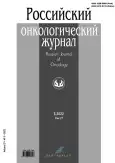Analysis of surgical treatment complications in patients diagnosed with pancreatic cancer
- Authors: Kaganov O.I.1,2, Orlov A.E.1,2, Kozlov A.M.1,2, Shvets D.S.2, Mikolenko N.I.2
-
Affiliations:
- Samara State Medical University
- Samara Regional Clinical Oncological Dispensary
- Issue: Vol 27, No 5 (2022)
- Pages: 221-228
- Section: Original Study Articles
- Submitted: 18.09.2023
- Accepted: 01.11.2023
- Published: 09.12.2022
- URL: https://rjonco.com/1028-9984/article/view/584050
- DOI: https://doi.org/10.17816/onco584050
- ID: 584050
Cite item
Abstract
BACKGROUND: The main treatment for pancreatic cancer is surgery. Often, invasion into neighboring anatomical structures requires reconstructive intervention on adjacent vessels, aggravating the complexity of surgical intervention and its outcomes. The operation of choice for cancer of the head of the pancreas is gastropacreatoduodenal resection, and for a malignant tumor of the tail, distal resection of the pancreas with splenectomy. These operations, especially gastropacreatoduodenal resection, are characterized by a high level of complications and mortality. Complications such as destructive pancreatitis and failure of the pancreatodigestive anastomosis remain the main cause of death. In our article, we will analyze the various complications that we encountered during our practice at Samara Regional Clinical Oncological Dispensary.
AIM: Аnalysis of complications after radical surgical interventions for pancreatic cancer in the Samara Regional Clinical Oncology Dispensary.
MATERIALS AND METHODS: The results of treatment of 99 patients with prostate cancer who underwent radical surgical treatment in the department of abdominal Oncology of the Samara Regional Clinical Oncology Dispensary since 2018 were studied. Gastropancreatoduodenal resection (GPDR) was performed in 43.4% of patients (n=43), distal pancreatic resection with splenectomy (DRP) — 40.4% of patients (n=40). In two cases, total pancreatoduodenectomy with splenectomy was performed for multifocal cancer of the head, body and tail of the pancreas.
RESULTS: In the course of our study, it was revealed that 43.4% of patients underwent gastropancreatoduodenal resection, 40.4% underwent distal pancreatic resection with splenectomy, and in 2 cases total pancreatoduodenectomy with splenectomy was performed. During gastropancreatoduodenal resection, a standard volume of lymph dissection was performed. After surgery, pancreato-gastro-anastomosis was formed in some patients, while pancreatoejunoanastomosis was formed in others. In patients who underwent distal pancreatic resection, the gland was crossed at the level of the isthmus, the splenic vessels at the base, with the removal of groups of lymph nodes. Combined operations were performed in 12.12% of patients. In the postoperative period, all patients received synthetic somatostatin analogues and proteolysis inhibitors.
CONCLUSIONS: Our study analyzed 30 patients who experienced complications after radical surgery for pancreatic cancer. 8.08% of patients developed a class C pancreatic fistula, 5.05% had a pancreaticogastroanastomotic leak, 4.04% had a pancreaticoduodenal anastomotic leak, and 2.02% had a subhepatic abscess. All complications were classified as clinically significant according to the Clavien–Dindo classification of complications IIIb or higher. In all cases, laparotomy and sanitation of the abdominal cavity were required. Postoperative complications also included intra-abdominal bleeding and gastrostasis. The mortality rate was 12.02%; the causes of death were pancreatojejunostomotic failure and pulmonary embolism. Pancreatic fistula class C and intra-abdominal bleeding were the most significant complications affecting the clinical outcome. Mortality was lower in patients who underwent distal subtotal pancreatectomy. Survival was also higher in this group of patients. The group with extended-combined operations showed no deaths.
Full Text
About the authors
Oleg I. Kaganov
Samara State Medical University; Samara Regional Clinical Oncological Dispensary
Email: okaganov@yandex.ru
ORCID iD: 0000-0003-1765-6965
SPIN-code: 2705-4187
MD, Dr. Sci. (Med.), Professor
Russian Federation, Samara; 50 Solnechnaya street, 443029 SamaraAndrey E. Orlov
Samara State Medical University; Samara Regional Clinical Oncological Dispensary
Email: orlovaesamaraonko@yandex.ru
ORCID iD: 0000-0001-6145-3343
SPIN-code: 8902-5712
MD, Dr. Sci. (Med.), Assistant Professor
Russian Federation, Samara; 50 Solnechnaya street, 443029 SamaraAlexey M. Kozlov
Samara State Medical University; Samara Regional Clinical Oncological Dispensary
Author for correspondence.
Email: a.m.kozlov@samsmu.ru
SPIN-code: 1793-2631
MD, Cand. Sci. (Med.)
Russian Federation, Samara; 50 Solnechnaya street, 443029 SamaraDenis S. Shvets
Samara Regional Clinical Oncological Dispensary
Email: shvetsds@samaraonko.ru
MD, Oncologist
Russian Federation, 50 Solnechnaya street, 443029 SamaraNikita I. Mikolenko
Samara Regional Clinical Oncological Dispensary
Email: nekit.mikolenko@yandex.ru
ORCID iD: 0009-0001-7479-155X
MD, Oncologist
Russian Federation, 50 Solnechnaya street, 443029 SamaraReferences
- Rasulov RI, Shelekhov AV, Man’kova TL, Neustroev VG. Extended gastropancreatoduodenectomy: detailed clinical and pathology analyses. Vestnik RONTs im. N.N. Blokhina RAMN. 2008;19(1):64–70. (In Russ).
- Kostina YuD, Pavelets KV. Diagnosis and treatment of pancreatic cancer the current state of the problem. Medicine: Theory and Practice. 2018;3(3):16–26. (In Russ).
- Kuchin DM. Vybor optimal’nogo sposoba formirovaniya pankreatodigestivnogo anastomoza pri gastropankreatoduodenal’noi rezektsii: Cand. Sci. (Med.) dissertation. Moscow; 2017. (In Russ).
- Katz MHG, Marsh R, Herman JM, et al. Borderline resectable pancreatic cancer: Need for standardization and methods for optimal clinical trial design. Annals of surgical oncology. 2013;20(8):2787–2795. doi: 10.1245/s10434-013-2886-9
- Egorova A.G., Orlov A.E., Somov A.N. and others. Malignant neoplasms in the Samara region in 2020-2021: a review of statistical information based on the results of processing the databases of the Samara Cancer Registry as of October 31, 2022. Indicators of morbidity, mortality, survival and health care status. – Saratov: Amirit LLC, 2022. – 392 p.
- Pancreatic cancer. Clinical Guidelines. ID 355. Approved by the Scientific and Practical Council of the Ministry of Health of the Russian Federation. 2020. Available from: https://cr.minzdrav.gov.ru/recomend/355_4 (In Russ)
- National Comprehesive Cancer Network Clinical Practice Guidelines in Oncology: Pancreatic Adenocarcinoma. Version 1 2022.
- Kaprin AD, Starinskii VV, Shakhzadova AO, editors. Sostoyanie onkologicheskoi pomoshchi naseleniyu Rossii v 2021 godu. Moscow: MNIOI im. P.A. Gertsena − NMRRC of the Ministry of Health of Russia branch; 2022. (In Russ).









